

| End-User Guide > Lifecycle Management Suite Workspace |
This section explains how to navigate within the workspace in the Lifecycle Management Suite.
The workspace displays a 360 degree overview of a person in the Lifecycle Management Suite and provides the ability to work all accounts and tickets for that person on one screen. Workspace screens can be configured by administrators to display institution-specific information within various person, account, or ticket panels in the overview section.
 |
While only one workspace is typically displayed for a single person in the Lifecycle Management Suite, there are instances where one person may have multiple distinct workspaces, with different accounts, due to the information received from the core or third party import. Reference the section below for an overview of the scenarios that could occur to create more than one workspace for a person in the Lifecycle Management Suite:
Scenario 1: Financial institution is on a person-centric core. During the core import, information is sent to the Lifecycle Management Suite that identifies two distinct person records. For example, if the core sends a Person Number, and the person has two different Person Numbers on record in the Lifecycle Management Suite, the information is not linked to a current workspace as the system cannot determine the Person Number to which the information should be linked. Scenario 2: Sufficient information is not sent for a person during a Third Party Import or Create Profile Import. For example, if the third party, or profile import, sends an unformatted SSN, the system may not be able to determine if the number is associated with an SSN or EIN; therefore, the information is not linked to a current workspace as there is not enough information to safely link the data in the import with a record in the Lifecycle Management Suite. |

The workspace toolbar is located on the top of all workspaces.

 |
When a screen is enlarged, the icons on the workspace toolbar wrap to the next line and are left-justified in order to maintain accessibility. |
Below is a list of the Toolbar icons and their descriptions:
| Toolbar Icon | Description | ||||||||||||||
| Click the Refresh icon to refresh the workspace being viewed. Any updates made to the workspace are displayed upon selecting this icon. | |||||||||||||||
Click the Full Screen icon to maximize the amount of space available to work a person. When selected, the icon appears active
|
|||||||||||||||
Click the Person Verification icon to turn Person Verification on or off for the workspace. This feature is controlled by the system administrator in System Management > Areas. When this feature is active, a person verification screen displays upon opening a person workspace through a Search. This screen contains security information used to verify a person’s identity. 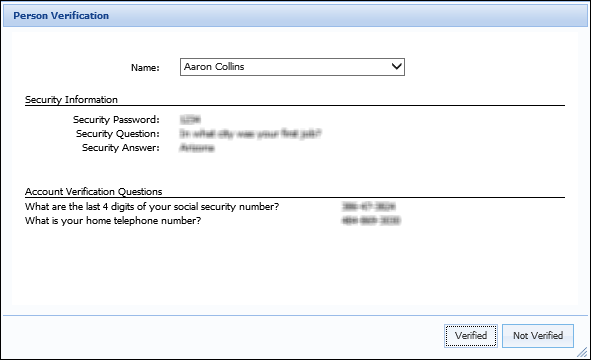
When Person Verification is on, the icon appears active and hovering over it displays a message to Turn Person Verification off.
Within the Person Verification message, a section for Security Information appears that includes a Security Password, Security Question, and Security Answer. These fields are configured on the Person Verification Screen created by a system administrator in System Management > Screens. When in a person workspace, the Person Verification screen can be accessed from the Screens tab on the Left Navigation panel. Once this screen is selected, it populates next to the overview tab in the workspace. The Person Verification screen consists of three fields:
Once all fields on the screen are complete, click Save. A success message appears to confirm that the screen saved successfully. The Security Password, Security Question, and Security Answer defined on this screen now display within the Person Verification message for the person in the workspace.
|
|||||||||||||||
The Queue Contents icon opens the list of accounts in the queue and provides access to other accounts in the current queue. This feature is controlled by the system administrator in System Management > Areas.
|
|||||||||||||||
Click the Create New Case icon to create a new case for the person in the workspace. The ability to use this feature is a security permission set by the system administrator.
|
|||||||||||||||
|
The Tools drop-down provides quick links to external websites, such as the Temenos website and the websites defined by system administrators in System Management > Hyperlinks. |
|||||||||||||||
| The Updated icon refreshes the person workspace from the host and displays when the last update occurred. If changes are made during the refresh, an information icon appears within this notification to alert users of these changes. Hovering over the |
|||||||||||||||
 |
The Area drop-down identifies the area being worked, as well as other areas that are available. | ||||||||||||||
 |
The Queue Selector drop-down displays the name of the queue being worked. Select the drop-down to see a list of all assigned queues and navigate to other queues. Selecting a queue from the drop-down opens an account in that queue. If no accounts are available in a queue, a message displays stating that no accounts are available in the selected queue and prompts to select another queue from the list.  When a queue is selected from the Queue Selector drop-down, an information icon appears and hovering over this icon displays the number of persons and accounts remaining to be worked in that queue. This feature is controlled by system administrators in System Management > Areas. 
|
||||||||||||||
|
The Get Next button allows the user to advance to the next person in the queue. This feature is controlled by the system administrator in System Management > Areas.
System administrators can configure icons to appear in a column within the Related Accounts panel to identify the accounts that must be worked before selecting Get Next. A workflow must be executed on the required account(s) in order to count them as worked and update the icon(s) within the Related Accounts panel. For more information on these icons, please see the Top Area Screen section of this topic. If Get Next is selected before the required accounts are worked, the following error message displays:
While working a case queue, the Get Next button allows users to skip active tasks in a case and get the next case in the queue. When tasks are skipped, they are rescheduled to be worked the following workday, adhering to the workday schedule assigned to the task.
|
|||||||||||||||
If another user is currently working the person in the workspace, an In Process message displays on the workspace toolbar. An information icon appears within this message to alert users that more information is available. Hovering over the icon displays the user that is also working the person.
|
The Person Summary Panel is designed to provide a quick, high-level overview of a person. The information that appears within this panel is system-defined and includes home address, the home, work, and mobile phone numbers related to the record for the person-in-context, email address, social security number (SSN), and date of birth. The address that displays within the Person Summary panel is the Default Home address identified in the database for that person.
 |
When the real-time refresh process runs, the Person Summary panel is automatically updated to display the most up to date information from the core for the person. |
 |
The content in the Person Summary Panel is driven by the person record selected to access the workspace. A person may include multiple person records such as joint checking accounts, third party mortgages, and third party credit cards that are grouped by SSN under a single Person Master record. This may cause a variation in the name displayed, as well as the home address. If a person record does not have a home address, any address associated to the person master record may be displayed.
|
The phone numbers displayed in the Person Summary panel are related to the record for the person-in-context.
 |
System administrators have the ability to determine whether phone numbers related to closed accounts appear in the Other Phones window as defined in the Collection Settings tab of the Collection page in System Management. If the parameter is set to false by the system administrator, any phone numbers related to closed accounts for the PersonMasterID are excluded from the list that appears in the Other Phones window. If the parameter is set to true, the list includes all phone numbers for the PersonMasterID, including the numbers associated with any closed accounts. For more information on this setting, please see the Collection Settings section of the Collection topic in the Administrator Guide. |
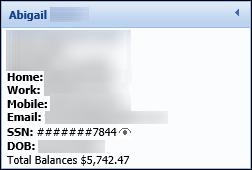
 |
The Person Summary Panel does not display duplicate phone numbers of the same Type. For example, if a Home phone number and Mobile phone number share the same Phone Number, both the Home and Mobile phone numbers display. However, if two Home Phone Numbers are entered with the same Phone Number, only one Home phone number displays. |
Administrators can also configure additional data to appear in the Person Summary by assigning Presentation rules to this area of the workspace. If rules are assigned to this area, a message displays within the panel to notify that rules are executing:

The additional data configured through rules appears below the current system-defined information once the workspace has completely loaded.
 |
When data is updated within the Person Summary panel during the real-time refresh process, any Presentation rules assigned to the area automatically re-run to display the most up to date information for the person. |
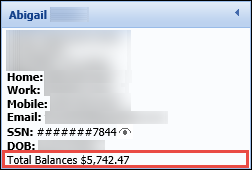
 |
A tooltip is included in the Person Summary panel to display only the last four digits of a Social Security number. The rest of the SSN is masked until the
|
The Left Navigation Panel displays four tabs: Favorites, Screens, Workflows, and Tickets. Use the filter within each tab for easy navigation to items within the lists. Simply type the name of the item that is being searched.

The Post Comment Box appears on the left navigation panel of the workspace. Comments are automatically posted to the person's workspace. Comments can be associated to specific accounts,in addition to the account holder.
Enter any text into the Post Comment text box.
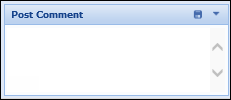
To post the comment click the ![]() icon. A Select Items pop-up window appears to associate accounts to that comment.
icon. A Select Items pop-up window appears to associate accounts to that comment.
 |
Depending on configurations made by the system administrator, the row for a delinquent account may display in different text and/or background color than a row for an account that is current, as shown in the below example. For more information, please see the Top Area Screen section of this topic. |

After selecting the accounts , click OK to post the comment. The comment appears on the Workflow History screen.
 |
Selecting an account is not required in order to post a comment. If an account is in context when posting a comment, that account is selected by default. If an account is not selected, the comment is posted for the person. |
To collapse the Post Comment Box, click the ![]() icon. When the Post Comment Box is empty, clicking the
icon. When the Post Comment Box is empty, clicking the ![]() icon also collapses the box.
icon also collapses the box.
The Overview Screen appears in the main section of the workspace, and is used to display information on the person being worked, as well as the account or ticket in context.
 |
This screen cannot be closed. |
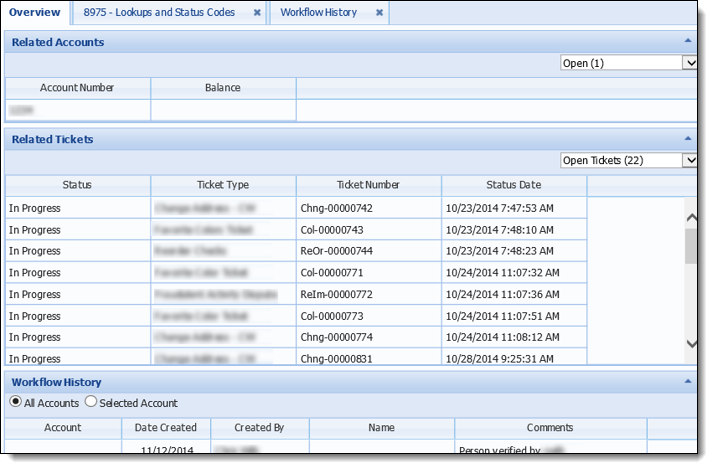
The screens that preload within the workspace load based on the person, account, and case types in context, when the workspace initially loads or is refreshed. For example, if a person record is used to access the workspace, only person screens display within the Overview screen.
The following matrix provides an overview of the screens that preload in the workspace based on the item in context:
| Person | Account | Case | Screens Preloaded in Workspace |
 |
Person | ||
 |
 |
Person Account screens matching the account type |
|
 |
 |
Person Case screens matching the case type |
|
 |
 |
 |
Person Account screens matching the account type Case screens matching the case type |
 |
As the selected account/case in the workspace changes, the preloaded screens for that account/case type will not be loaded. Preloaded screens are only used when initially loading the workspace. |
Information within some panels displayed in the Overview screen can be viewed for all accounts or only the selected account by clicking All Accounts or Selected Account within the panel.
 |
Panels default to a selection of All Accounts. |

Through some panels, screens can be accessed, and other workspaces can be opened. For example, if the overview screen is configured to include the Related Persons panel, clicking on a Person within that panel displays a new workspace for that related person in a separate tab.
 |
Information for a Joint account holder, such as the Joint account holder's primary address, appears in the Related Persons panel when the panel is configured to appear in the Workspace Overview. |
 |
If a related person is restricted, the person is not displayed in the related persons panel. Also, any accounts associated to the restricted person do not display in the Related Accounts. |
Similarly, clicking on a workflow on the Workflow History Panel opens the Workflow History screen.
When accessing screens and executing workflows for a person, account, or ticket, the screen or workflow tab loads next to the Overview tab as shown below:
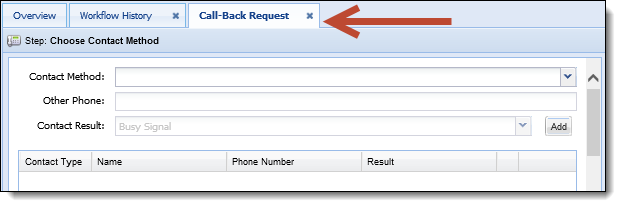
The information displayed within the Overview screen automatically refreshes upon the selection of a new account or ticket in the Related Accounts or Related Tickets Panel.
 |
In order for information within a panel on the Overview screen to update as a new account or ticket is selected, the panel must be configured to appear on the Person screen mapped to the overview tab in the workspace. Clicking a row within the Related Accounts or Related Tickets panel only refreshes the information within the Overview screen. |
This automatic refresh does not occur when a new screen is opened. When a new screen is opened in the workspace, the information for the selected account or ticket displays and does not refresh if a new account or ticket is chosen within the Related Panels. To change the information that displays on a new Account screen, use the drop-down within the top of the Screen tab.

 |
If the account/case in selected in the Related Account/Case panel does not match the account or case selected in the drop-down, the background of the account/case drop-down displays as red. Users are also presented with a tooltip there is an account mismatch between the item selected in the Related Account/Case panel, and the drop-down. Click the link within the tooltip to reload the screen with the account/case selected in the Related Account/Case panel.
|
The Overview screen can be configured by system administrators to include Person, Account, or Ticket panels that populate to display information regarding the specific account or ticket in context.
 |
If any address, phone or email panels are configured to appear in the Overview screen, the information in these panels cannot be edited as these panels are read-only. For more information on these panels, please see the Screens topic in this guide. |
When a new account or ticket is selected within a related panel, the information automatically refreshes in the Overview to reflect information for the account or ticket in context. Depending on the configuration of the Overview screen, additional panels may display when users change the account or ticket in context.
For example, when a user selects a credit card account, panels displaying transaction and payment history related to the account populate in the Overview as shown below:
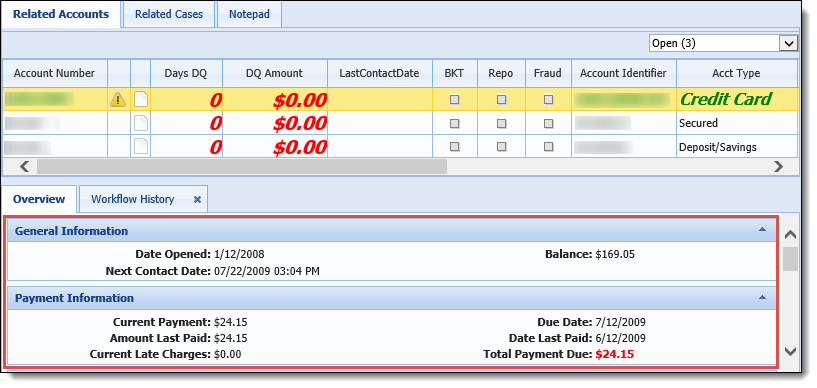
The top area screen appears within the top section of the workspace, and displays all account for the person in context when configured to include the Related Accounts Panel.
 |
The top area is not recommended for the Service module; however, depending on configurations made by the system administrator, the Related Accounts panel may be configured to appear in the workspace Overview. |
 |
Within the Related Accounts panel, accounts are displayed in ascending order by account id, with the oldest account listed first. The maximum number of accounts displayed in the panel is controlled by the Max Accounts to Load database parameter. By default, this parameter is set to 150 to display the first 150 accounts for a person in the panel. If an account is not displayed in the Related Accounts grid due to the value set in the Max Accounts to Load parameter, it must be searched for using the Lifecycle Management Suite's standard search functionality.
|
![]()
 |
When the real-time refresh process runs, data within the Related Accounts grid is automatically updated to display the most up to date information from the core for the person. |
For this panel to display, system administrators must configure a Person screen to include the Related Accounts panel. The fields that display within each panel are configured by the system administrator in System Management > Screens.
One of the columns that can be configured to display within the Related Accounts panel is Queue Information. Queue information alerts users to important queue messages by displaying a queue indicator icon within the column.
![]()
Hovering over the icon displays the following information about the account:
| Icon | Description | Tooltip |
 Empty Box Empty Box |
The account is not in a queue. | No message displays. |
 |
The account is in the current queue. | This account is in the queue being worked. |
 |
The account is in the current queue and must be worked before selecting Get Next. | This account is in the queue being worked and must be worked before getting next. |
 |
The account is in a different queue. | This account is in the [name of queue] queue. |
 |
The account is in a different queue and must be worked before selecting Get Next. | This account is in the [name of queue] queue and must be worked before getting next. |
 |
The functionality of the Queue Information  icon and icon and  icon is determined by the Get Next setting configured by the system administrator in System Management > Areas. If no accounts are required to be worked before selecting Get Next, then these icons do not appear. icon is determined by the Get Next setting configured by the system administrator in System Management > Areas. If no accounts are required to be worked before selecting Get Next, then these icons do not appear. |
As queues are changed, the icons update to reflect the queue that is currently being worked. For example, in the screenshot below, the  icon appears for account 101277 and identifies that the account is in the 16-30 days DQ queue:
icon appears for account 101277 and identifies that the account is in the 16-30 days DQ queue:

Working the 16-30 days DQ queue updates the Queue Information column to display the  icon identifying that the account is in the queue being worked.
icon identifying that the account is in the queue being worked.

If an icon includes a pencil, such as the  icon and
icon and  icon, then a workflow must be run on the account before Get Next can be selected.
icon, then a workflow must be run on the account before Get Next can be selected.
 |
If the workflow run on the account is configured by the system administrator to Deactivate Account in Queue, the account is removed from the queue upon completion of the workflow, and the Queue Indicator icon for the account is also removed from the Related Accounts panel after the workspace is refreshed. |
In addition to the Queue Indicator Icons, the following icons can also be configured to appear within a column in the Related Accounts panel, providing immediate access to important account information for the person in context as they are hovered over in the workspace:
| Icon | Description | Tooltip | ||||||
 |
The account is delinquent.
|
This account is delinquent. | ||||||
| The account is associated with one or more open cases. | Case Number(s) and Case Type(s). |
Selecting any account within the panel highlights the row, and refreshes the contents that pertain to the selected account in the workspace Overview.
 |
Right-clicking on a row in the Related Accounts/Cases panel provides users the option to reload the workspace with the account/case in context.
|
 |
If any address, phone or email panels are configured in the top area screen, the information in these panels cannot be edited as these panels are read-only. |
![]()
Use the drop-down in the top right-hand corner of the Related Accounts panel to determine if All Accounts, Open, Open Liable, Delinquent, Delinquent Liable, or Closed accounts display within the panel.
 |
This drop-down defaults to Open Accounts. |
 |
A person is liable on an account if their Role Type on the account is set to Liable as configured by a system administrator in System Management > Role Types. |